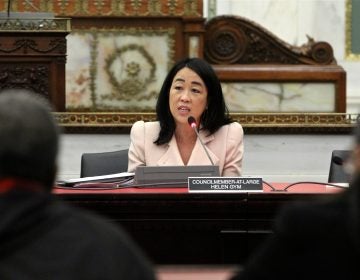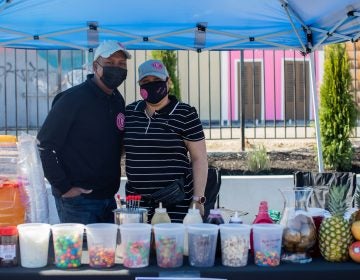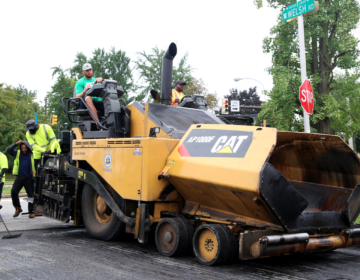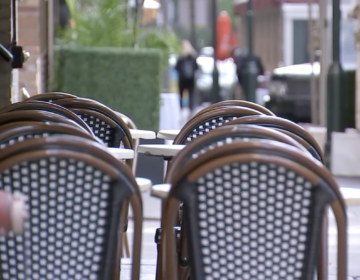How one Philly ‘streetery’ experiment became a victim of its own success
As a popular dining destination faces city orders to rebuild a costly outdoor dining setup, advocates call for a clearer plan for opening up streets.
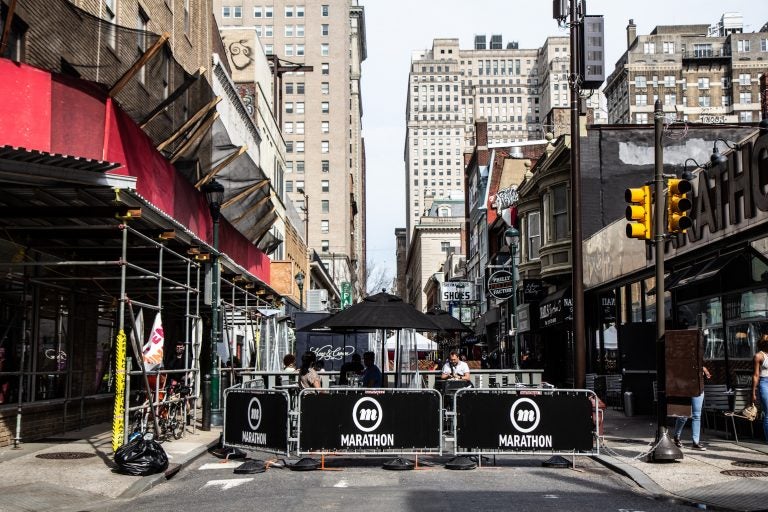
The 1500 block of Sansom Street in Center City Philadelphia is closed for outdoor dining. (Kimberly Paynter/WHYY)
During the day, the 1500 block of Sansom looks like an outdoor festival frozen midway through setup — popup tents and police-style barricades are mixed in with wooden sheds custom built for outdoor dining.
By night, it’s one of Philadelphia’s biggest successes in an experiment with converting conventional city blocks into “streeteries,” or outdoor dining areas burnished by the closure of parking or traffic lanes. The experiment has attracted throngs of diners and bargoers and sustained restaurants and bars hit by the pandemic.
But now, as the city’s street closure pilot turns one year old, even some advocates for pedestrianizing more of the city say a lack of leadership or planning has turned areas like the Sansom Street block into a cluttered mess.
“What they’ve done by shutting down the whole street is really made it inaccessible,” Dena Driscoll, a member of the urbanist PAC 5th Square, said. “I would love to see the street shut down to cars all the time. But we don’t just want to swap out private cars for private business.”
The issues were cast in starker relief last week. Several businesses on Sansom recently sought and received a permit from the city’s Department of Licenses and Inspections to pack even more table space into the narrow street by constructing larger and more permanent sheds that span the entirety of the roadway. But that permit conflicted with another issued by the city’s Streets Department that shut the street to traffic in the first place — under the condition that at least 10 feet of contiguous space be left clear for emergency vehicles.
The two city agencies — among 10 separate departments that technically oversee what officials call an “expanded outdoor dining program” — failed to communicate about the crossed permits, so the businesses moved ahead with construction without leaving the space necessary for emergency vehicles.

The happy hour-friendly sheds started going up last week, leaving just a sliver of already-narrow sidewalks. When city inspectors pieced together what was happening, they hit the businesses with stop work orders, The half-finished platforms and piles of lumber now remain in the middle of the street.
Kevin Lessard, deputy communications director for Mayor Jim Kenney explained that normally such conflicts would be automatically flagged by the city’s permit software, but that did not occur given the unusual nature of the street closure.
“Given that the street closure program was created as a temporary measure to close streets for a few days at a time, a similar flag has not been built for addresses that are within blocks with active street closure permits,” he said.
Even so, he said the structure will now have to go. Corie Moskow, a public relations consultant acting on behalf of Rittenhouse Row, a consortium of businesses on that strip and sections of 18th Street that are similarly closed to traffic, suggested that would likely cost “tens of thousands of dollars.”
She described the whole snafu as a simple miscommunication and said she still hopes to work with the city and cut the structure down to an acceptable size.
“I don’t think anybody did anything wrong or was trying to do anything wrong,” Moskow said. “I think the issue is the city [government] is a big group. One department says ‘go ahead’ and another says ‘stop.’”
A complex experiment
Lessard, Kenney’s spokesperson, is inclined to dismiss the Sansom Street shed incident as a one-off anomaly as the city juggles the needs and desires of a variety of businesses and city agencies.
“The street closure program has been running for nearly 11 months and this is the first issue of this type, so it’s a leap to conclude that the program is too complicated for the restaurants,” he said.
But in some ways, the program is complex.
City officials still regard places like the 1500 block of Sansom and nearby blocks that were similarly shut for expanded outdoor dining as part of a kind of ad-hoc “pilot program” pieced together last year as restaurants clamored for alternatives to indoor dining restrictions spurred by COVID-19. Every city agency that might have a concern about such a plan was corralled to help get it off the ground: Streets, L&I, the Managing Director’s Office, the Office of Transportation, Infrastructure and Sustainability, the Health Department, the Law Department, Commerce, the Mayor’s Office, the Fire Department, the city’s Planning Department.
It was an impressive feat for municipal government. But Eryn Santamoor, chief of staff for City Councilmember Allan Domb, whose office has championed the street closures, acknowledged the project was in something of a limbo state, guided by a diffuse committee with no permanent regulations.
“It touches all these different parts of the system,” she said. “I think everyone is at the table. But they’re going through the stages of grief. There’s no more anger but there is still some bargaining.”
But to advocates, like Driscoll, Sansom Street is illustrative of the growing pains facing City Hall as the street closure proves increasingly popular with owners and patrons alike — and increasingly likely to stay for good.
While she praised the evolution of other areas shut to traffic for dining, like a section around 13th and Sansom, she said it’s been clear for some time the many groups involved did not have a clear vision for what blocks should ideally look like.
The city’s permits require Americans with Disabilities Act compliance. But some advocates say people with disabilities would have had a tough time navigating the block even before the larger structures went up and businesses crowded the block.
“There are obstacles all along the way,” said Tom Earle of Liberty Resources, an advocacy group that sued the city in 2019 over inaccessible sidewalks. “Restaurants and bars with tables and chairs and signs out on the street and sidewalks have made an area that was already difficult to navigate and out of compliance even worse.”
Driscoll, a parent, said the issues were little better for those with children in strollers. She worried the possibility of unintended accessibility issues could jeopardize efforts down the road to pedestrianize more streets.
“We’re preventing people from using the street,” she said.
Santamoor said Domb — a real estate mogul, who owns several properties featuring restaurants that benefit from street closures — wants to craft a permanent set of rules and regulations by the end of the year. But Lessard, Kenney’s spokesperson, said the program will likely continue in its current form in the meantime.
“We are holding regular discussions with the restaurant business community and are looking at the complicated issues around what elements of the program will make sense to continue beyond 2021,” he said.

A better system
Santamoor said that — as far as Domb’s office is aware — there haven’t been any real complaints about shutting more streets to cars or expanding al fresco dining. Not from residents, business owners, or district councilmembers who have some say over street closures. She views the stop work orders on Sansom Street as a lesson.
“I think as we think about the permanency of it, we have to use these examples of safe and sound policy,” she said. “We didn’t anticipate this happening, but it happened and it could happen in the future. I don’t think anyone wants this to fail.”
Still, businesses on Sansom are likely facing the prospect of dismantling and rebuilding half-complete dining sheds, a costly endeavor after a year of lost business. And advocates for both pedestrianization and accessibility, like Driscoll, say the broader issues were both predictable and preventable.
“Now is the time that if we’re making these permanent we need to start talking about having real regulations and saying what these should look like,” Driscoll said. “We need to have the ‘come to Jesus’ moment.”
Many other U.S. cities, from New York to Los Angeles, have experimented with increasing street closures to free up space for more outdoor dining. Numerous cities around the world have successfully pedestrianized entire neighborhoods. Philadelphia itself features both public and private pedestrian-only zones, like Maplewood Mall in Germantown and the Piazza in Northern Liberties.
“We get that restaurants are desperate for outdoor seating,” said Earle. “We’re convinced it can be done in a way that allows pedestrians and people with disabilities to navigate safely.”

Subscribe to PlanPhilly
WHYY is your source for fact-based, in-depth journalism and information. As a nonprofit organization, we rely on financial support from readers like you. Please give today.



